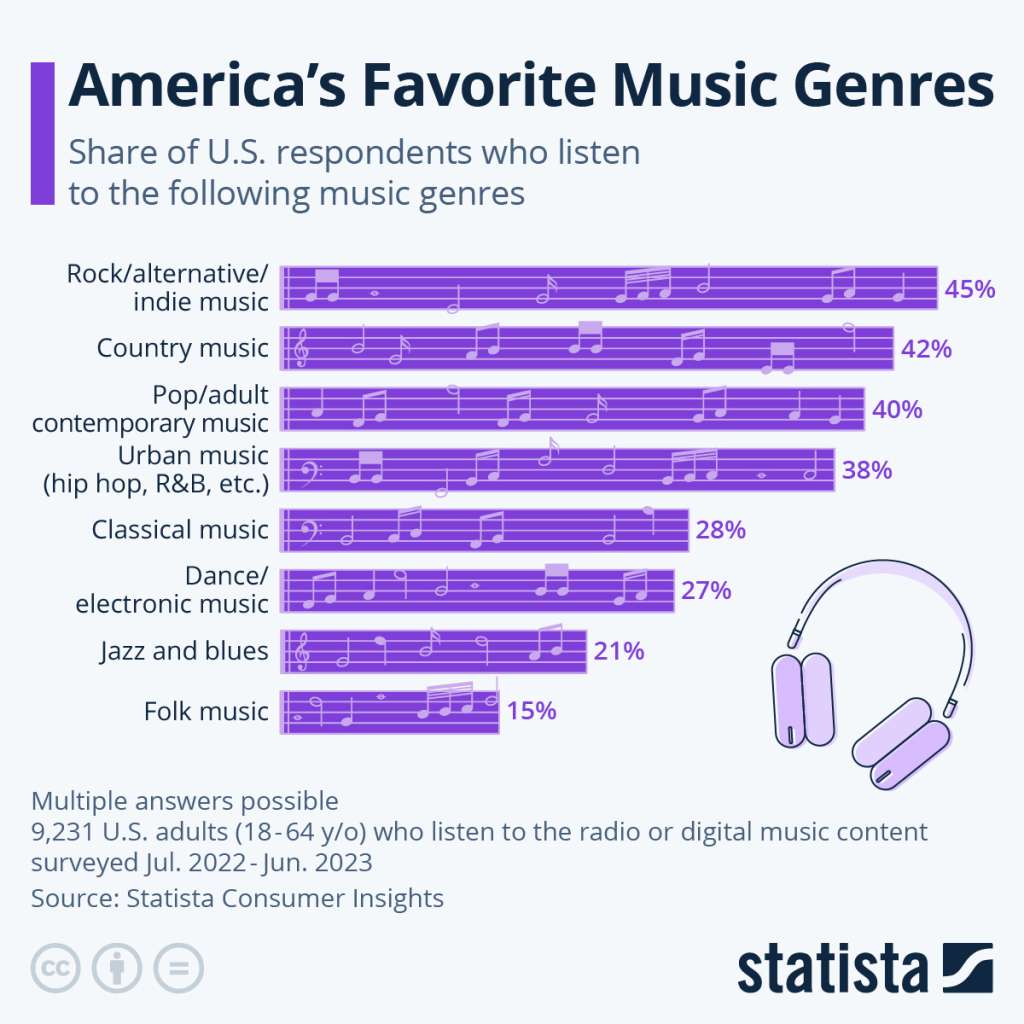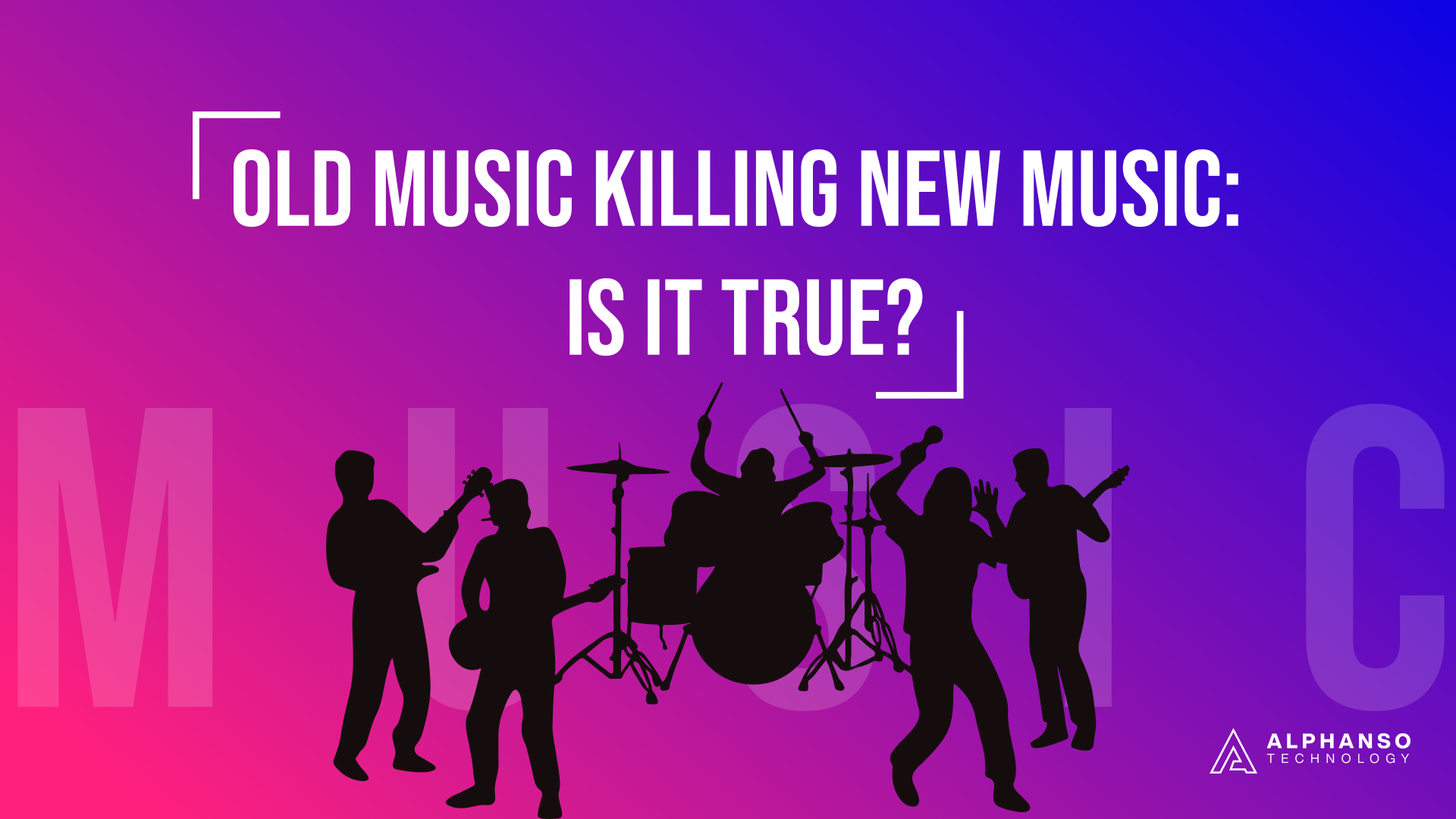In recent years, there’s been a lively debate in the music world: Is old music overshadowing new music? This question stirs up many thoughts about our listening habits, streaming trends, and the timeless charm of classic hits. Let’s explore whether old music is really dominating the scene and what this means for the future of new artists.
Is Old Music Killing New Music?
The evolution in the music industry over the last has made “what you listen” a crucial personality construct. However, it is rooted in many cultural and social tribes, and for many music lovers, self-perception is associated with musical preference. We would be reluctant to admit that the taste of music lovers alters and softens with time.
Statista report shows that the favorite genres among consumers in the U.S. differ. One of the popular genres in the U.S. is Indie music and rock. In the survey, more than 45% of respondents agreed that they listen to digital music content including pop and country music. More than 41% of female listeners agreed that they listen to urban music, including hip hop while this number is high compared to 36% of men who prefer to listen to music in the U.S.

Source: (Statista)
Different types of music are considered boosters. It is available in different languages, however, to stay modern we have changed our preferences and taste in music, but most prefer to enjoy old songs rather than going for new ones. Hence it said,
“Old is gold and here to stay for longer.”
Some people listen to rap and other music with beats but prefer to avoid the ones that have a negative effect on their minds. Old songs represent almost 70% of the U.S. music market. Those who make new music now find this figure trembling and fearful. The new music is getting worse hence the market of new music is shrinking steadily.
Reasons that Explain Why Old Music is Killing the New One!
The MRC Date report shows that 70% of Americans choose to go with the old music when they are listening to a song; the number is 19% higher than it was a year ago. However, current tunes experience an almost 3.7% drop in the listening percentage.
The report also shows that the board listening to new music has decreased by a whopping 17.9% from 2020. However, time spent with older music increased by 24% in Canada. However, if you look at streaming, traditionally inhabited by young people has declined by almost 5.3%.
The most popular 200 tracks regularly account for 5% of total streams. The rate was three times higher a few years ago. The mix of songs customers purchase is more titles towards old music. The most downloaded and listed tracks on iTunes are names of brands from the past century.
The pandemic may be contributing to this boost. The ultimate investment in the business area is old tunes. Hence it is not incorrect if we say that old music is killing new ones. More and more investment firms are stepping into a bidding war to buy catalogs from aging pop stars.
The issue is not a lack of good music; it’s an institutional failure to nurture and discover new brands. However, there are very few people who seem to care about the new music, which is resulting in a shrinking market. There are many more reasons how and why old music is killing new music.
Is Old Music Better Than New Music?
In some ways, yes. Great music is made regardless of the era; it’s that which we might not get to hear much these days. Record labels drive what is popular; whatever the current trend is, they want more of it. Labels and artists were not afraid to change in the 1970s and ’80s, which resulted in providing us with a wide variety of great music to select from.
There were no sub-genres of music; all fit under the big umbrella that everyone cared about. Today we are all more about the niche and algorithms that feed us with the same things that we listen to instead of something new and interesting that we love the most.
It’s A Little Too Easy
Top streaming content on an app like Spotify is written using the method called “toplining.” It means the song is written over the premade beats, one that is purchased online. For example, in Old Town Road by Lil Nas X, the music is composed over the chords and beats.
Modern technology has made songwriting easier for the artist than ever before. Artists are not spending years mastering instruments like piano, guitar, or any other. Instead, they find a loop made by someone, but the hits that we are often exposed to are not lighting up the earbuds of even the demographic that they aim at.
Why practice new instruments, learn and try to form a band, or how record, when all you have to do, is recognize a beat or loop that you like and assemble the song from there? That is not to say there have not been some wonderful songs that came about that way, but a loop is a few factor in songwriting as it encourages two-chord songs with a simpler melody. Plus, add the fact that there are more writers on some songs as well and you have the lowest standard denominator in songwriting that is guaranteed not to take chances.
Easy Availability of Old Music
The only way to possess streaming content was to purchase a record store. But the biggest retailer might stock 100,000 titles from across all genres of music. The primary focus was selling new records.
Each of the streaming platforms presents something like 95 million tracks, which is close to the entirety of humanity’s recorded music, all instantly at any time. It enables people of all ages to check more music than ever before. Many people are agnostic when it comes to the era and genre of their favorite music. All they care about are suitable songs.
Ending Note
Music is here to stay for longer; it is going through cycles and trends. If you are of a certain age, you would love to hear the early 1970s music. You might hear about Happy Days, Sha-Na-Na-Na, American Graffiti, and Elton John, who was one of the biggest stars of the era, releasing hits including Crocodile Rock.
You can also launch your music streaming software with hits of your work. If you are looking to achieve the next big hit like other music streaming platforms are doing, we can help you with the same.
FAQs: Old Music Killing New Music
Why do people prefer listening to old music over new music?
Nostalgia plays a big role. People often have an emotional connection to the music they grew up with. Additionally, algorithms on streaming platforms tend to recommend older, well-loved tracks, which keeps them in the spotlight.
How does the popularity of old music impact new artists?
The dominance of old music makes it challenging for new artists to get noticed.
Are new songs getting worse?
It’s not necessarily that new songs are getting worse, but the music industry has shifted towards producing songs that fit current trends and popular algorithms. This can lead to a perception that new music lacks the variety and innovation seen in past eras.
How have streaming services influenced the resurgence of old music?
Streaming services have extensive libraries that include both old and new music. Their algorithms often recommend older tracks that have historically performed well, making them more prominent in listeners’ playlists.
What role does technology play in the current state of music?
Modern technology has made it easier for artists to create and distribute music, but it also encourages a focus on popular trends and simpler production methods. This can sometimes result in less musical variety and innovation.
Is the music industry investing more in old music?
Yes, investment firms and music industry stakeholders are increasingly purchasing catalogs of old music, seeing them as a stable investment. This trend can divert attention and resources away from nurturing new talent.
Can old and new music coexist?
Absolutely. The relationship between old and new music can be symbiotic. Old music provides a foundation and inspiration for new creations, and both can thrive with proper support from the music industry and diverse listening habits.

